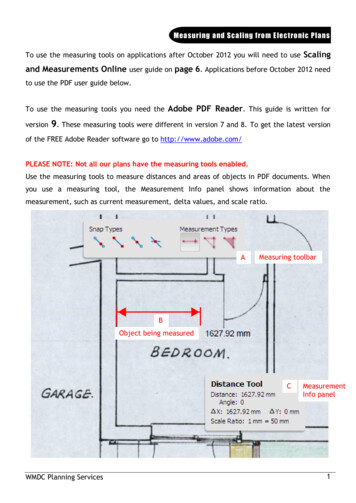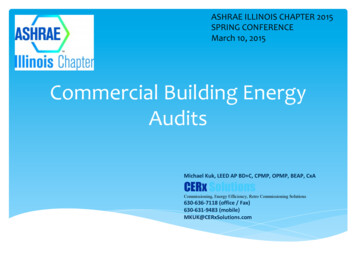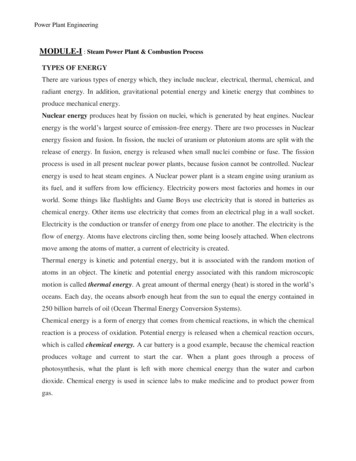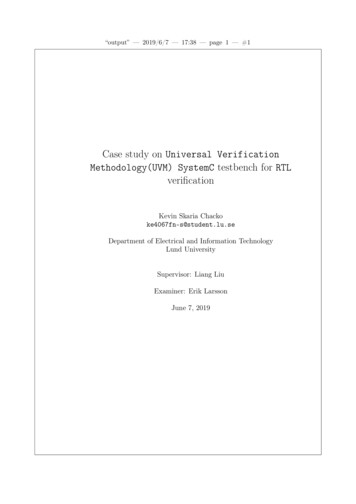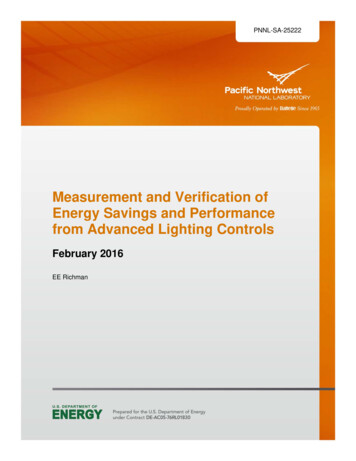
Transcription
PNNL-SA-25222Measurement and Verification ofEnergy Savings and Performancefrom Advanced Lighting ControlsFebruary 2016EE Richman
PNNL-SA-25222Measurement and Verification ofEnergy Savings and Performancefrom Advanced Lighting ControlsEE RichmanFebruary 2016Prepared forthe U.S. Department of Energy Federal Energy Management Programunder Contract DE-AC05-76RL01830Pacific Northwest National LaboratoryRichland, Washington 99352
ContactsProject ManagerLinda SandahlPacific Northwest National LaboratoryPortland, OR(509) 375-2609Linda.Sandahl@pnnl.govProject ManagerSaralyn BunchFederal Energy Management ProgramWashington, DC(202) 586-3267Saralyn.Bunch@EE.Doe.Goviii
AbstractThis document provides a framework for measurement and verification (M&V) of energy savings,performance, and user satisfaction from lighting retrofit projects involving occupancy-sensor-based,daylighting, and/or other types of automatic lighting. It was developed to provide site owners, contractors,and other involved organizations with the essential elements of a robust M&V plan for retrofit projectsand to assist in developing specific project M&V plans. It provides an overview of how to conduct energymeasurements and develop cost-effectiveness analyses to evaluate energy savings and compare differentlighting control systems where applicable.v
Acronyms and Abbreviationsfcfootcandle(s)CIEInternational Commission on IlluminationFEMPFederal Energy Management ProgramkWhkilowatt-hour(s)LEDlight-emitting diodeM&Vmeasurement and verificationO&Moperations and maintenanceUFCUnified Facilities Criteriavii
ContentsContacts . iiiAbstract . vAcronyms and Abbreviations . vii1.0 Background and Application Summary. 12.0 Measurement and Verification Activity Details . 22.1 Basic Considerations . 22.2 Site Selection and Setup . 32.2.1 Stable Operational Baseline . 32.2.2 Stable Conditions for Measurement . 32.2.3 Equipment Burn-in and Warm-up . 32.2.4 Measurement Access . 42.3 Instrumentation Recommendations . 42.4 Energy Measurement Method . 52.4.1 Total Circuit Measurement Method . 82.4.2 Sampling Measurement Method . 82.5 Energy Measurement Application Details . 82.6 Basic Light Level Measurement Protocols . 102.7 Occupant and Installer and Operator Experience Assessment . 122.8 Operations and Maintenance and Other Cost Savings . 123.0 References . 13Appendix A Additional Guidance for Accurate and Repeatable Illuminance Measurement . A.1Appendix B Sample Survey Instruments .B.1TablesTable 1. Recommended Instrumentation Specifications. . 5ix
1.0 Background and Application SummaryThis document provides a framework for M&V of energy savings, performance, and user satisfactionfrom lighting retrofit projects involving occupancy-sensor-based, daylighting, and/or other types ofautomatic lighting control. It is designed to assist in developing specific project M&V plans and supportcost-effective retrofits (partial and complete replacements) of lighting system controls, and is intended toserve the following purposes: Provide a foundation for M&V plans for occupancy sensor and other automatic lighting controlretrofits following a “best practice” approach that considers engineering accuracy as well aspracticality. This document may need to be customized for individual applications. Provide site owners, contractors, designers, and other involved organizations with the essentialelements of a robust M&V plan for lighting projects.The plan and details in this document have wide applicability across all building types and can be auseful tool in supporting the federal requirements for the use of lighting controls in federal agencyfacilities. In applications where the Unified Facilities Criteria (UFC) (U.S. Army Corps of Engineers2016) and the General Services Administration PBS-P100 (P100) guide (U.S. General ServicesAdministration 2014) allow and encourage the use of occupancy sensors and other lighting controls, thisdocument provides methods for evaluating and verifying the effectiveness of the controls and thepotential energy savings. Note that the UFC and P100 documents place some restrictions on whereoccupancy sensors can be used and how wireless communication protocols for controls can be applied.Other documents available through the Federal Energy Management Program (FEMP) provide guidanceon the practical application of occupancy sensors in various space types and facilities. Consult thesedocuments for lighting control applications and guidance.This M&V approach is specifically tailored for retrofit projects involving automatic lighting controlsuch as occupancy sensors or more involved advanced lighting controls. The M&V approach outlinedherein contains many parameters. The prescribed methodologies were developed considering technicalaccuracy and practicality. Capturing control savings typically requires additional monitoring andcalculation compared to simple lighting technology changes (i.e., fluorescent to light-emitting diode[LED] lamp retrofits). This M&V plan can apply to projects where there is interest in comparing savingsamong different control systems. The installation, setup, and calibration of occupancy sensors, daylightsensors, and other lighting controls often involves manufacturer-specific steps and procedures that cansignificantly affect the control’s function and therefore the energy savings. This setup and calibration foreffective function is beyond the scope of this document. Consult the product manufacturer’s setup andcalibration guidance to ensure that controls are optimized.1
2.0 Measurement and Verification Activity DetailsThis section details each primary element of a useful and effective M&V plan. Specific guidance onapplying the plan in varying field conditions is included to accommodate common differences in projectapplications.2.1 Basic ConsiderationsFor measurements to provide a useful comparison of different lighting control technologies, severalconditions must be considered: Operating hours: Operating hours should be identified during an initial survey of the facility and areassumed to be the same before and after the retrofit. Savings (or increased energy use) associated withchanges in facility operating hours should not be considered when evaluating the potential for energysavings from an installed or modified control system, and should be considered separately. Existing lighting controls: If lighting controls other than the new control or control modificationbeing implemented already exist in the areas to be measured and are not being replaced, it isimportant that these existing controls function the same before and after the retrofit if possible. Thisensures that the energy effect of just the new control can be measured by having existing control bethe same before and after. If it is not possible or practical to maintain existing controls, it is desirableto deactivate these controls for a reasonable period (2 weeks preferred) prior to installing the newcontrol to provide a comparable baseline of pre-existing conditions for comparison. Light levels: Typical occupied lighting levels (illuminance on task surfaces) are often necessarily orunavoidably changed from pre-retrofit to post-retrofit conditions. Implementing changes in lightlevels with the installation of a new lighting system (with or without controls) will affect the occupiedenergy use and therefore potentially skew results of any comparison involving energy savings.Therefore, it is important to capture occupied lighting levels before and after the retrofit to be able toadjust savings for a fair comparison or at least recognize that this change is an important element ofthe project energy savings or increase. Site selection: The specific characteristic of an evaluation site or area can have a large effect of themeasured potential savings. If daylighting is part of the control system, the evaluation site(s) withdaylighting characteristics should be as similar to the expected applications as possible. If more thanone control system is being evaluated, the evaluation areas selected should be similar to one another.This would include areas facing the same orientation to the sun, having similar/identical windowlayouts, and having similar clear or obstructed views related to solar angles. If occupancy sensing ispart of the control system, evaluation site(s) should have an occupancy that is as close as possible towhat would be typically expected in anticipated applications. Because occupancy in work spaces isextremely variable depending on worker type and activity, it is important to have as large a set ofoccupants as possible in each evaluation area. This helps support measured energy use data that is asclose to statistically valid as possible. If more than one control system is being evaluated, theevaluation areas selected should be similar to one another. Heating and cooling system effects: Potential effects on the energy use of heating and coolingsystems from changes in lighting energy use are beyond the scope of this plan. Heating and coolingenergy use can be affected by interior lighting changes, but in most cases (other than in extreme2
climates) the heating and cooling interactions at least partially offset each other or are relativelyminor.2.2 Site Selection and SetupAn effective comparison of lighting controls requires an environment and conditions that eliminateunnecessary variables that could invalidate the results. All installations and real-world conditions areunique; however, equivalent conditions are needed for a reasonable comparison. Each setup conditiondescribed below should be evaluated in terms of potential effects on collecting useful data.2.2.1Stable Operational BaselineWhen assessing any lighting control system, it is desirable that the basic lighting system be in stableoperating condition both before and after the retrofit of controls. This ensures that the effect of only thenew control is captured in any measured energy savings. However, lighting retrofits commonly involvemultiple changes, including lamp technology (i.e., fluorescent to LED) and light level adjustments (i.e.,increase or reduction to meet recommendations or occupant needs). These changes will affect energy useand therefore affect any fair comparison of control options or true energy savings from an installedcontrol. Thus, it is highly desirable and important for the analysis to either eliminate or otherwiseaccommodate for these other variables.The energy use of lighting technology changes and light level changes can be roughly accounted for.This energy use that is separate from control savings can be adjusted for by measuring the power draw ofboth the pre- and post-retrofit lighting systems at full power (typical operation when any automaticcontrols are not activated). The difference in power can then be applied to any energy savings data toremove the effect of the technology or light level change to provide energy savings from the controlapplication only.The effect of controls on the new technology may result in differences in its steady state power draw,but these would be expected to be minor and would likely not affect any comparison analysis. Thecontrols may also affect the longevity of the lighting, which is addressed separately in the operations andmaintenance section.2.2.2Stable Conditions for MeasurementThe test site chosen should provide stable conditions before and after the retrofit installation. Physicalsite changes that could affect results include electrical circuit reconfigurations or interior renovations thatwould disrupt normal facility operations. The conditions most likely to affect the data collected include achange in occupants, holiday schedules, and changes in occupant tasks or schedules. If changes such asthese are likely in the test area(s), their effect on collected measurements should be carefully consideredor an alternate site chosen.2.2.3Equipment Burn-in and Warm-upFor newly installed retrofit or replacement lighting equipment, the energy consumption and lightoutput may change until the product has been operated for a reasonable amount of time (also known as3
seasoning). This has been a concern for some fluorescent systems, but is typically not of much concernfor other technologies including LED.Some lighting technologies such as compact fluorescent light and linear fluorescent can take time towarm up to stable operating conditions when first turned on at the start of a business day. This can beparticularly true in colder conditions. Therefore, for both baseline and post-installation measurements ofenergy and light levels, the system should be allowed to warm up to typical operating conditions.Appropriate warm-up periods will vary depending on the technology, but 1 hour should cover all interiorand exterior situations.2.2.4Measurement AccessThe test site should provide easy access to the circuits serving the test lighting system. Theilluminated area should be available for light level measurements during periods when potentialobstructions (e.g., vehicles, occupants, customers, and temporary materials or equipment) and daylightcan be avoided. It is important to avoid daylight conditions in order to specifically evaluate the electriclighting system only.2.3 Instrumentation RecommendationsThe measurement of real world application of lighting controls is necessarily going to includepotentially wide uncertainty. This is simply because of the natural variability in the architecture of spaces(daylight availability) and the activity of occupants (occupant sensor activation) which directly drivesadvanced control energy use and savings. Therefore, unlike other laboratory and field measurementactivities, the measurement of building energy use in real world situations does not require extremelysmall measurement tolerances to be effective. However, consistent measurement and reasonable accuracyare still important.Measurement equipment can have listed uncertainties that can help in understanding the variability ofthe energy use that is recorded and lower uncertainties are naturally preferred. At the same time, energyuse can vary significantly because of the human factor (occupancy sensors) and solar availability(building architecture and location). These variabilities are likely much larger than any equipmentuncertainties. Therefore, while equipment accuracy is important, it is not a critical parameter beyond atight tolerance within a few percent. However, this M&V plan does recommend minimum accuracyrequirements for measurement instruments that are reasonably achievable with standard availableequipment. Table 1 provides instrument specifications appropriate for the types of measurementapplications covered in this M&V plan. Specific brands or manufacturers are provided as examples onlyand do not represent an all-inclusive list. Testing documentation should include the actual specificationsand measurement accuracies of any equipment used. If the accuracy is significantly less than the valueslisted in Table 1, the measurements may not be suitable because they would introduce additional error tothe energy calculations.4
Table 1. Recommended Instrumentation ight on/offdata loggerPower meter(for e real timeenergy use viacircuit or panelMeasure run time oflighting fixturesEstablish true powerof baseline and newlightingcontrols/systemsEstablish functionalperformance ofbaseline and newlighting equipmentMeasurementUncertainty and RangeUncertainty: 1 % of readingUncertainty: 1 minute per week;Light thresholdadjustment range:1 to 100 fc (10 to1,000 lux)Uncertainty: 3%Decimal precisionMeter CharacteristicsBrand Name(a)ExamplesWattnodeOnset-HoboExtechOnset ComputerHobo LoggersDent InstrumentsSmartLoggerOmega OM-53Power factor calculationFlukeand/or adjustment.ExtechHigh sampling rate of 240hz Hoboor better preferredUncertainty: 3% 3% deviation from cosineMinoltaRange: 0.1 fc (1.0function for reported singlePhoto ResearchCookelux) to 10,000 fcvalue or 10% at incidenceExtech(100,000 lux)angle of 60 for multipleangle reported values.AmprobeSolar LightSpectral response within10% of the CIE spectralluminous efficiencyfunction(a) Brand names listed are examples only. Associated products may not meet all of the requirements in this table.Verification of the individual equipment is required.2.4 Energy Measurement MethodThe measurement of energy typically involves the installation of equipment inside live electricalpanels and the attachment of equipment to live circuits. This work necessarily requires a level of safetypractice and diligence that is practiced by electricians and individuals who are trained to install energymonitoring equipment. Specific safety procedures and protocols to accomplish this are out of the scope ofthis document. This document focuses on the protocols and suggested metering and measurement formatsneeded to capture energy use data for lighting control system evaluation. Specific electrical installationtechniques and safety methods should be addressed by the equipment installer.Measuring the energy use of a lighting project may be of interest for different reasons. Two primaryreasons for measurement are: 1) to determine savings for a specific project to validate project costeffectiveness, identify savings towards a programmatic goal, and/or for use in project cost reimbursementcontracts and 2) for use in estimating potential energy use/savings over a wide set of applications. Energymeasurement of lighting controls for either of these reasons presents similar challenges.Measuring the energy use of a variable load produced by a lighting system with advanced occupancysensor and daylighting controls is more involved than measuring the difference in energy from a simpletechnology retrofit (i.e., fluorescent to LED). This is directly because of the variability in hours and/orlevels of operation with these systems from unscheduled occupancy control and daylight dimmingcontrol. Some installations that involve only simple automatic on-off control from basic occupancysensors may be measured with one time power measurements and runtime lighting loggers. However, this5
will not work in most advanced control systems with individual fixture-embedded control and/or daylightdimming or step control. Therefore, the most realistic method for capturing actual energy use withadvanced control systems including occupancy sensing is true energy metering over time.The measurement of energy to meet the two primary reasons noted previously can effectively beaccomplished by: 1) measuring the entire power circuit system that serves the entire project area (totalcircuit measurement method) or 2) measuring a sample of representative space types, fixtures, orindividual circuits within the project area (sampling measurement method).The total circuit measurement method is generally preferred when only the total savings for a specificproject is needed. This method typically captures the energy consumption of the complete project withoutrelying on estimates from a few example spaces to generate a project total. The sampling method isgenerally preferred if the collected data is to be used to estimate savings for a variety of potential projects.This method can provide specific data on space type energy use that is more useful for estimation across avariety of building types. Both of these methods are described in more detail below.Regardless of the measurement method chosen, some basic measurement principles should befollowed as part of a successful metering approach: Site setup documentation: Photographs and sketches of the test site conditions, energy measurementsetup, and measurement points within panels or circuits are recommended to provide a record of theconditions to be applied for repeated sets of measurements. These will help identify obstructions andother conditions that may affect future measurements. Representative operations/areas: Measurement of a complete lighting system with controls for anentire facility can be the simplest method for capturing energy use and savings. However, this may bedifficult because of possible mixed loads on lighting circuits, and estimation may need to be applied(see the description of the total circuit method in 2.4.1). For M&V projects where the data may beused to estimate savings for other buildings or locations, the mix of space types in the building beingevaluated may not be representative of these other buildings. It is therefore often more practical tomeasure representative spaces within a facility when possible. It is important to measure as manyspaces as possible that represent the majority of typical operations to provide a useful average for thespace type that is as close as possible to a statistically valid savings value. Measurement periods: Facility operations vary with time, seasons, holidays, and other businessactivity. Therefore, it is important to capture a long enough operating period to reasonably representstandard operation. An entire year of measured data could be ideal but this is typically impractical andshorter periods must be considered. To account for typical business operational variance, this istypically at least 2 weeks of normal non-holiday operation. More time is preferred if businessoperations vary over a typical 2-week period (e.g., changing tasks or hours of operation). Holidaysand vacation periods are then accounted for separately based on business schedules. It is alsodesirable to measure continuously for the entire period and not just on business days or duringoperating hours because off-hour operation of the control is also an important part of the total system.In addition to business operational variation, seasonal changes related to daylighting can alsosignificantly affect energy use when daylighting control is part of the lighting system. In these cases,a separate set of issues with the measurement period arises with those lighting controls that involvedaylight sensing control capabilities. See the section below for guidance on dealing with seasonaldaylighting energy savings. For capturing energy use after installation of lighting system controls, thesame 2-week or more time periods are recommended.6
Multiple control layers: If the control system has multiple control layers (i.e., occupancy sensing plusdaylighting), then where possible, it is useful to capture periods of 2-weeks or more with each controllayer separately operating. With some advanced control systems, this may not be easily accomplishedbut it should be part of the metering plan in order to separately capture daylight control savings withthe system. Daylighting assessment: When daylighting control savings can be separately measured, there aremultiple issues that will affect the accuracy of the resulting estimate of savings. Daylight availabilityvaries greatly with the architecture of the facility (window shape and location, overhangs, blinds).Daylight availability also varies over the entire year and with the building’s geographic location.Longer energy measurement periods can help capture the seasonal variability of daylight throughoutthe year, but typically this will be considered impractical. Analysis and computer modeling of variousarchitectures in buildings of interest can help develop ratios that can be applied to one building’smeasured data for application in other buildings. However, this is also likely not practical for thetypical retrofit project. For energy savings estimates that can be used to prioritize projects, simplermethods and realistic project approaches may be appropriate and necessary.–Daylight control savings over an entire year for a building can be estimated by using a simpleratio of solar radiation that directly drives daylighting energy savings. The appropriate ratio inthis case is the total solar radiation for the year (Wh/yr/m2) divided by the solar radiation duringthe measurement period of 2 weeks or more (Wh/measurement period/m2). This ratio multipliedby the energy use measured during the measurement time period calculates an estimated energyuse for the year as follows:Estimated yearly EU (ASR/MPSR)*(MPEU)where EU is energy use, ASR is the total annual solar radiation for the site location, MPSR is totalsolar radiation during the measurement period for the site location, and MPEU is the energy usemeasured during the measurement period.–The difference between energy use for measurement periods with and without the daylightcontrols activated will provide an estimate of the energy savings available from the use of thedaylight controls. A useful database of hourly solar availability data can be found as part of theNational Solar Radiation database (National Renewable Energy Laboratory 2012) in the form ofTypical Meteorological Year (TMY3) data1.–Daylight control savings estimates from one building can be applied to another building if thearchitecture (window configuration and orientation) is the same for both buildings. In this casethe ratio used isTSR proposed building location/TSR measured building locationwhere TSR is total solar radiation.This ratio when multiplied by the estimated yearly energy use for the measured building providessimilar yearly estimates for the energy use in the proposed building. This can provide a rough butrealistic estimate of the potential savings over an entire year at different locations with similararchitecture.1TMY data is available by location and time of year at: http://rredc.nrel.gov/solar/old data/nsrdb/1991-2005/tmy3/7
–2.4.1If the architecture of multiple buildings is different, applying simple daylight savings radiationratios to estimate possible energy savings in other buildings is not realistic. The realistic approachin most projects like this is to have a determination made of the applicability of daylightingcontrols in each location. This would necessarily involve a lighting design professional but is theonly realistic method of ensuring that daylighting controls are only installed where they may beeffective.Total Circuit Measurement MethodThe total circuit measurement method involves identifying the circuit(s) that serve the baseline andpost-installation lighting systems. Typically, these are the same circuit(s) and can provide a directrepresentative measurement of actual energy for the project. This is most appropriate when the goal of theevaluation is estimating the total savings in a specific building or application only and it is not intended tobe applied to other projects.In some cases because of mixed loads on circuits, the total lighting load for a building may not beeasily measured. Estimating total project lighting energy use from energy metering for a majority of theproject area can still be appropriate. In these cases the total energy use for a building can be estimatedusing ratios of the metered square footage and the total square footage. For this estimate to be valid, it isdesirable to capture as much of the project energy use as possible. A value of at least 75% isrecommended. Less than 75% may still be valid if it can be considered representative of the entire area.Specifically, for less than 100% of the project area, the circuits measured should: 1) provide power to amix of spaces that are the same as the mix of spaces in the entire project and 2) the circuits should be asclean as possible and not include non-lighting loads or loads from neighboring areas that are not part ofthe project.2.4.2Sampling Measurement MethodThe sampling measurement method involves measuring the energy use of a representative sample ofthe spaces in a project and using this data to extrapolate to the energy use of the entire proj
In applications where the Unified Facilities Criteria (UFC) (U.S. Army Corps of Engineers 2016) and the General Services Administration PBS-P100 (P100) guide (U.S. General Services Administration


